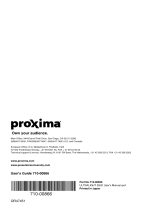
Table of contents2
Important safety
instructions ................... 3
Introduction.................. 7
Projector features.....................................7
Shipping contents ......................................8
Projector exterior view...........................9
Positioning your
projector ..................... 15
Choosing a location................................15
Obtaining a preferred projected image
size..............................................................16
Connection ................. 17
Connecting a computer or monitor...19
Connecting Video source devices.......21
Operation ................... 25
Starting up the projector ......................25
Adjusting the projected image .............26
Using the menus......................................29
Securing the projector...........................30
Switching input signal .............................32
Magnifying and searching for details ...33
Selecting the aspect ratio ......................34
Optimizing the image .............................35
Setting the presentation timer .............39
Remote paging operations ....................40
Hiding the image......................................41
Freezing the image ..................................41
Operating in a high altitude
environment.............................................42
Adjusting the sound................................42
Personalizing the projector menu
display ........................................................43
Use teaching template............................44
Select the lamp saver mode.................45
Controlling the projector through a LAN
environment.............................................46
Displaying image through Q Presenter ..
.................................................................... 57
Using the projection login code.......... 60
Projecting MX661 QPresenter App... 61
Presenting from a USB Reader............ 66
Shutting down the projector ............... 69
Menu operation ...................................... 70
Maintenance ............... 84
Care of the projector............................ 84
Lamp information ................................... 85
Troubleshooting......... 93
Specifications.............. 94
Dimensions .............................................. 95
Ceiling mount installation ..................... 95
Timing chart............................................. 96
Warranty and Copyright
information............... 103
Ta b l e o f c o n t e n t s




















 Proxima DP6850 Manuale utente
Proxima DP6850 Manuale utente
 Proxima Ultralight S520 Manuale utente
Proxima Ultralight S520 Manuale utente
 Proxima Ultralight S520 Manuale utente
Proxima Ultralight S520 Manuale utente